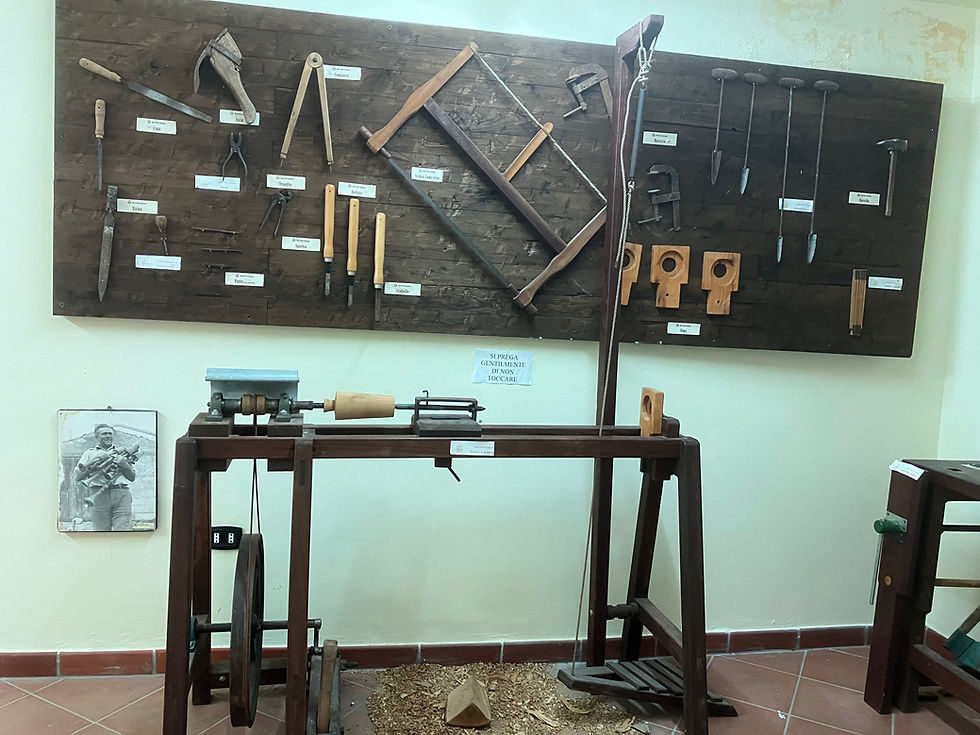Pietre di più. Note di più.
- Antonio Forte
- Sep 4, 2023
- 3 min read
More stones. More notes. While thinking about the time I spent at Pietrabbondante, staring at the stones found in the walls there, I could not help but marvel at the non-uniformity of the shapes. They seemed to be improvisations, frozen in time; polygons placed without any previous forethought, but everyone perfectly aligned in their relationship to those others directly tangent. Purposeful purposelessness. No two stones were the same, yet they all worked together to achieve a certain harmony that has lasted millennia. I've been so inspired by these robust structures, and what they have come to symbolize for me, that I've started to transcribe the shapes into just that: multiple harmonies based on tangential, unique shapes.

[Caption: Polygonal stone wall at Pietrabbondante.]
I began with a single image I had taken of the polygonal stone walls. Each polygon represents one repeated melodic "cell." That is, as ones eyes trace the edges of a stone, each corner will be a different pitch, and the distance between two corners will determine the rhythmic value of each pitch. To figure this all out I traced each of the polygons and began superimposing the individual shapes onto the Circle of Fifths (a music symbol/tool used in both music theory and practice: basically, all twelve tones of the modern Western musical scale spaced evenly around a circle, like the twelve numbers of a clock, or the twelve colors on an artist's color wheel).
[Caption: Tracing and numbering the stone polygons. Superimposing the chromatic circle around each stone (stones 2 and 5).]
I decided to switch to a chromatic circle rather than that of 4ths/5ths, and to rotate/mirror the chromatic circle to allow for more variation. Additionally, the further along the stones I transcribed, the more difficult it became to simply apply pitches to each corner according to the circle. This was because not all chromatic circles were aligned perfectly, and I wanted each corner to be a single note. An interesting puzzle presented itself. For example, if one polygon's highest corner was the note A, and the polygon above it had a different note, then it needed to be rotated until it matched the A, which would then affect the other polygons around it...It took me a few days to finalize everything and begin transcribing the individual shapes into actual musical notation. Upon reflection, I realize now, in a way, it is as if I had to rebuild the stone wall myself, stone by stone (albeit on paper). It made me think of the Samnite stone masons over 2000 years ago. Did they set out with a plan, or did they chisel and shape each individual stone as it was placed?

[Caption: Finalized visualization of pitches for the polygonal stone wall section.]
Without having measured the exact dimensions of each stone in-person, nor taking the time to mathematically scale them from the digital image, I approximated the different distances between corners/pitches using the eighth-note as the smallest unit of measure and estimating the rest visually (quarter-notes, half-notes, etc.). As the wall goes higher, so too the pitches.

[Caption: Completed transcription of each of the 17 stones into music notation.]
This piece will eventually be composed for string quartet, but will be loosely notated (as the "cells" above, perhaps) and with accompanying written instructions. In short, the quartet will be free to choose which stone to place when, and must work together to build their proverbial polygonal, musical stone wall. The piece will be different each time it is performed, to parallel the physical uniqueness and non-uniformity of Pietrabbondante's walls.
The title for this piece, in Oscan, is:
𐌔𐌉𐍄𐌃𐌞𐌚 𑇐 𐌌𐌉𐌍𐌉𐌚𐌀𐌔 𑇐 𐌔𐌝𐌄𐌉𐌍𐌍𐌄𐌁𐌌𐌞𐌊
Phonetically: KÚMBENNIEÍS 𑇐 SAFINIM 𑇐 FÚRTIS
This translates to "The Strong Walls of Samnium." I had difficulty finding a suitable Oscan translation for "wall," but instead decided upon KÚMBENNIEÍS, which seemed more fitting. It is the name for a meeting, or "coming together" of a group of people, or for the structure inside which they are meeting. The word for "strong" was easily found attested, and is remarkably close to the Latin fortis and the Italian forte...
Stay tuned for the next post. What do stones sound like?









Comments